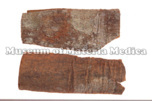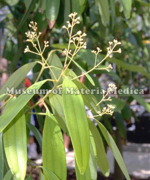Cinnamon Bark

|
Market name:桂皮 Photo location:Museum of Materia Medica, Inst. of Nat. Med. TMPW No.:4681 |

|
Plant name:Cinnamomum cassia Photo location:Kyoto Pref., Japan Photo date:1989 Photographer:S. Yamaji |
| Synonym | |
| Latin name | Cinnamomi Cortex |
| Botanical source: Family name | Lauraceae |
| Botanical source: Plant name | Cinnamomum cassia J.Presl (IPNI:77109079-1) |
| Part used | Bark (young branch) |
| Empirical criteria for quality selection | The one produced in Guangnan Prov. of China has thin bark, whereas the Vietnumese one has thic bark. The inner color of good one is charcoal brown or purplish black in color. It is pungent and has a fragrant odor (TN). |
| Constituents | Other aliphatic and related compounds: [C. verum]: Cassioside, Cinnamoside Monoterpenoids: C. verum: l-Phellandrene, α-Pinene, β-Pinene, Geranial, Camphene, Linalool, Terpinen-4-ol; [C. sieboldii]: Camphene, Linalool, 1,8-Cineole Diterpenoids: [C. cassia]: Cinnzeylanine, Cinnzeylanol, Anhydrocinnzeylanine, Anhydrocinnzeylanol, Cinncassiol A, Cinncassiol B, Cinncassiol C1, Cinncassiol C2, Cinncassiol C3, Cinncassiol D1, Cinncassiol D2, Cinncassiol D3, Cinncassiol D4, Cinncassiol E; [C. verum]: Cinnzeylanine, Cinnzeylanol Phenylpropanoids: [C. cassia]: Cinnamaldehyde (= Cinnamic aldehyde), Cinnamyl acetate, Phenylpropyl acetate, Cinnamic acid, Salicyl aldehyde; [C. verum]: Cinnamaldehyde (= Cinnamic aldehyde), Eugenol; [C. sieboldii]: Cinnamaldehyde (= Cinnamic aldehyde) Tannins: Cinnamtannin A1; [C. cassia]: l-Epicatechin, Procyanidin B-2, Procyanidin B-5, Procyanidin C-1, Cinnamtannin I; [C. verum]: l-Epicatechin, Procyanidin B-1, Procyanidin B-2, Procyanidin B-5 |
| Pharmacological effects | Sedative, analgesic (water extract, essential oil:excess amount induces spasm). Antibacterial (essential oil:against pathogenic mold). Blepharoptosis, antihypertensive, decrease of temperature, acceleration of respiration, arousal, enhancing bile secretion, inhibition of stress ulcer (cinnamaldehyde). Increasing perspiration, local anesthetic (water extract). |
| Indications | As a diaphoretic, antifebrile, aromatic stomachic and carminative, it is applied to treat headache, fever, hot flashes, wind-cold, dizziness and body pain. Its essential oil is used as a corrigent, perfume and spice. |
| Diseases | Common cold, Neuralgia, Rheumatism, Chronic bronchitis, Irregular menstruation, Amenorrhea, Abdominal pain, Diarrhea, Feeling of heavy and dull |
| Formulas | anchusan , anchusankabukuryo , ifuto , ireito , inchingoreisan , uzukeishito , unkeito , ogikeishigomotsuto , ogikenchuto , ogibekkoto , orento , kakkonkajutsubuto , kakkonkahangeto , kakkonto , kakkontokasenkyushin'i , karogaihakuto , karokeishito , kanzobushito , kigikenchuto , kyukichoketsuindaiichikagen , kumibinroto , keikyososooshimbuto , keishieppito , keishikaogito , keishikakakkonto , keishikakeito , keishikakobokukyoninto , keishikashakuyakushokyoninjinto , keishikashakuyakudaioto , keishikashakuyakuto , keishikajutsubuto , keishikabushito , keishikaryukotsuboreito , keishikaryojutsubuto , keishikanzoto , keishikanzoryukotsuboreito , keishikyoshakuyakukashokushitsuryukotsuboreito , keishikyoshakuyakuto , keishishakuyakuchimoto , keishito , keishinieppiitto , keishinieppiittokajutsubu , keishininjinto , keishibukuryogan , keishibukuryoganryokayokuinin , keishibushito , keimakakuhanto , kenchuto , kojito , kobokushichimotsuto , goshitsusan , goshakusan , goshajinkigan , goreisan , saikatsugekito , saikatsutokasenkyushin'i , saikokaryukotsuboreito , saikokeishikankyoto , saikokeishito , saireito , shakanzoto , shokenchuto , shoseiryuto , shoseiryutokakyoninsekko , shoseiryutokasekko , shozokumeito , shobaito , shinsentaitsuko , juzentaihoto , jurokumiryukiin , sesshoin , senkin'naitakusan , soshikokito , zosonmokuboito , zokumeito , daiseiryuto , chukenchuto , chokoshiteito , jidabokuippo , teikiin , tokakujokito , tokikenchuto , tokishigyakukagoshuyushokyoto , tokishigyakuto , tokito , dokkatsukakkonto , dokkatsuto , nyoshinsan , ninjin'yoeito , hachimijiogan , hachimisenkiho , hangesankyuto , byakkokakeishito , bukuryokanzoto , bukuryotakushato , bunshinkiin , henseishinkiin , hohaito , hontonto (chugoho) , boibukuryoto , maokajutsuto , maoto , meiroin , mokuboikyosekkokabukuryoboshoto , mokuboito , yokuininto , ryokito , ryokeikansoto , ryokeijutsukanto , ryokeimikanto , renjuin |
| Meridian tropism | Heart, Lung, Urinary bladder |
| Property | Warm |
| Flavor | Acrid/pungent, Sweet |
| Classification in "Shen-non Ben-cao Jing" | Superior |
| TCM: Classification | Diaphoretics (Drugs for dispelling internal cold) |
| TCM: Medicinal effects | To supplement body fire, to reinforce yang, and to lead the fire back to the kidney, to dispel cold and to relieve pain, to activate blood circulation and to stimulate menstrual discharge. Used for impotence, frigidity, feeling of coldness, pain in the loins and knees, dyspnea in deficiency syndrome of the kidney, dizziness, inflammation of the eye and sore throat due to yang deficiency, precordial and abdominal pain with cold sensation, vomiting and diarrhea in deficiency-cold syndromes, neurosis with a feeling of gas rushing up in the chest to the throat from the lower abdomen, amenorrhea and dysmenorrhea. |
| Remarks | Listed in the Japanese Pharmacopoeia 18th ed. |
| References | TN: T. Namba & Y. Tsuda ed., Outline of Pharmacognosy, a Textbook, 3rd ed., Nankodo Co., Ltd., Tokyo, 1998. |
DNA sequences of medicinal plants
| Gene Region | |||||||||||||||||||
| Nuclear | Chloroplast | Mitochondria | |||||||||||||||||
| Botanical source: Plant name | 5Ss | 18S | ITS1 | 5.8S | ITS2 | 26S | others | trnH-psbA | matK | trnK | trnK-rps16 | trnT-L | trnL | trnL-F | rbcL | rpoC1 | ndhF | others | |
|
|
|||||||||||||||||||
